Download document () of 20
Download
You have exceeded the download limit
Server Racks Explained
A server rack is a specialized enclosure designed to house IT equipment. It provides a secure and organized environment for servers, UPS systems, switches, and other IT devices.
Server racks come in a variety of sizes and configurations, ranging from small desktop units to large floor-standing models. In this article, we will cover the different types of rack, and how to find the right rack for your needs.
Provide organization and security for critical equipment
Server racks have sturdy steel frames and locking cabinets to secure and organize up to 3,000 lbs. of 19-inch rack equipment. They provide safe homes for servers, storage, network hardware and all the indispensable devices that keep your network efficient and productive.
Deliver efficient cooling
Most network racks feature front-to-rear airflow that supports efficient hot-aisle/cold-aisle configurations and exceed server manufacturer requirements to keep equipment operating reliably. Roof and panel fans are also available to optimize cooling efficiency.
Support diverse applications
Many server rack heights, widths, depths and other variations are available, with a wide range of configuration options so support any application.
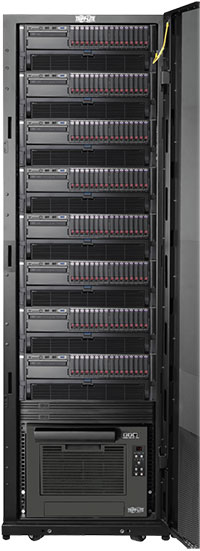
Makes your job easier
Most server racks have been designed to optimize installation and maintenance, and that philosophy shows in the details that make routine tasks quicker and easier, adding up to big benefits over the workday.
Features like quick-adjust mounting rails, modular side panels and toolless mounting slots for vertical PDUs and cable managers facilitate installation and configuration. Seamless compatibility with all EIA-standard 19-inch rack equipment ensures trouble-free
There are several types of server racks available, each with its own unique design and features. Here are some of the more common types.
Cabinet Racks are fully enclosed racks with locking doors and side panels. They provide better security and protection for equipment and are ideal for use in data centers or areas where physical security is a concern.
Key Features: secure, pre-assembled
Open-Frame Racks are a simple solution for mounting IT equipment in secure environments that don't require a lockable rack. They provide fast, easy access to equipment and cabling, and unobstructed airflow.
Key Features: easy access, cost-effective
Wall-Mounted Racks are designed to be mounted directly onto a wall. They are compact, secure, and ideal for network closets, classrooms, and other locations with limited floor space.
Key Features: secure, space-saving
Low-Profile Racks are smaller than standard server racks. They are designed for non-IT environments where space is limited, such as classrooms, retail locations, offices, and hospitals.
Key Features: small, secure
Industrial-Grade Racks are designed for specific equipment types or environments, such as factories, outdoor or hazardous locations.
Key Features: sealed, secure
Portable Racks are fitted with casters so they can be easily moved. They are ideal when equipment is racked in one location then moved to another.
Key Features: mobile, sturdy
Vertical-Mount Racks are a type of server rack designed for environments where space is extremely limited, such as back offices, wiring closets, or retail locations. These racks are wall-mounted and have a vertical orientation, which minimizes the rack's depth.
Key Features: shallow depth
Sound-Proof Server Racks are specially designed to reduce the noise produced by IT equipment. They are typically used in environments where noise levels need to be minimized, such as recording studios, offices, or residential areas.
Key Features: quiet
Heavy-Duty Rack Enclosures are specially designed to accommodate heavy equipment, including servers used in AI applications. They are constructed from reinforced steel that is 2.5 millimeters thick with extra welds and gussets, extra connection points, and upgraded casters and levelers to support more weight.
Key Features: heavy duty
Casters can be a useful addition to a server rack, as they provide mobility and ease of movement. Casters allow you to easily move the server rack around the room, making it easier to rearrange equipment or access cabling at the rear of the rack.
Casters also make it easy to move the server rack away from the wall for cabling changes or cleaning. This can be especially useful if the rack is situated in an environment where dust and debris can accumulate, such as in manufacturing or industrial settings.
Casters are useful for temporary installations, such as trade shows, concert performances or exhibitions. They allow you to easily transport the server rack from one location to another and set it up quickly.
When populating a rack with pre-installed casters, make sure it will roll through a standard 7-ft. (2.13 m) doorway if it needs to be moved to its final location.
A server rack grounding wire creates an electrical connection between the server rack and the grounding system in a data center or server room. The purpose of this connection is to establish a path for voltage surges or electrostatic discharge (ESD) to flow safely into the earth or ground, thereby preventing damage to sensitive electronic equipment housed in the server rack.
The grounding jumper typically connects the metallic parts of the server rack, such as the frame, doors, and side panels, to a grounding point, which could be a grounding busbar or a grounding electrode.
The ANSI/TIA-942 standard for data center infrastructure includes a four-level rating for grounding.
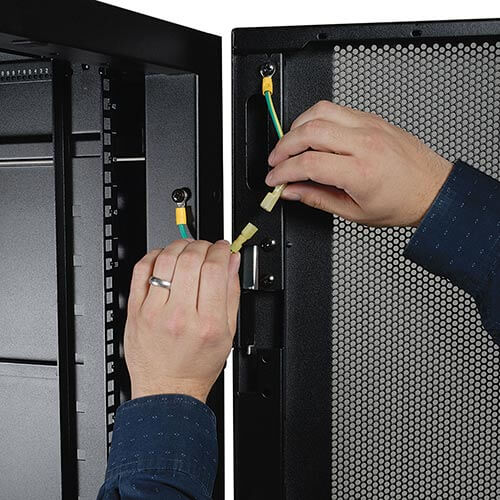

Square-hole mounting is a standard method used in many server racks. It involves mounting equipment using square holes punched into the vertical mounting rails of the server rack. Square-hole mounting offers greater flexibility in positioning equipment as it allows for vertical adjustment in increments of 1.75 inches (44.45 mm), which is the standard height of a rack unit (U).
12-24 threaded-hole mounting is an alternative method of attaching equipment to a server rack. It involves mounting equipment using threaded holes in the vertical mounting rails of the server rack. The holes are threaded with a 12-24 thread pattern, which means that they have 12 threads per inch and are compatible with 24-gauge screws. This method is less common than square-hole mounting but is sometimes used in specific types of server racks or with equipment that requires it.
The choice between square-hole and 12-24 threaded-hole mounting will depend on the equipment and the type of rack used. Many racks support both methods, allowing for greater flexibility in configuring the equipment.
Server rack baying tabs, also known as baying brackets or joining kits, are metal brackets or plates used to connect multiple server racks side-by-side.
Baying tabs are typically bolted or screwed onto the vertical frame of the server racks, securely connecting adjacent racks to form a stable row.
The center-to-center width of most baying tabs can be set at 600mm or 24" to match the width of standard data center floor tiles.
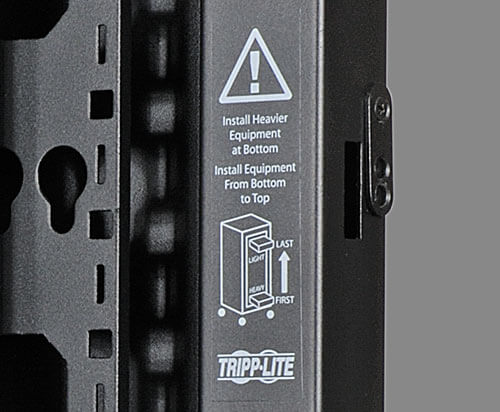
Accessories can enhance the functionality and performance of your rack. Here are some of the most common accessories:
Cable Management, such as cable managers and raceways, help to organize and route cables, which improves airflow and makes it easier to access and maintain equipment.
Cooling Fans are used to improve airflow and reduce heat buildup in the server rack. They are available in various sizes and can be mounted on the rack or on individual equipment.
Shelves and Drawers are used to provide additional storage space within the server rack. They can be used to store equipment manuals, tools, and other accessories.
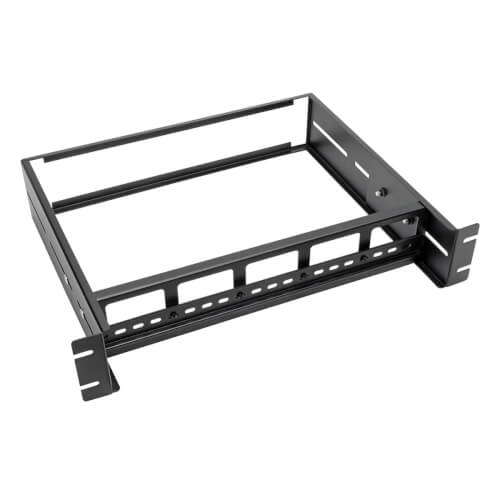
Rails and Mounting Hardware are used to secure equipment to the server rack. They are available in various sizes and configurations to accommodate different equipment types.

Monitor and Keyboard Trays are used to provide a convenient location for a monitor and keyboard within the server rack. They can be mounted on the front or rear of the rack.
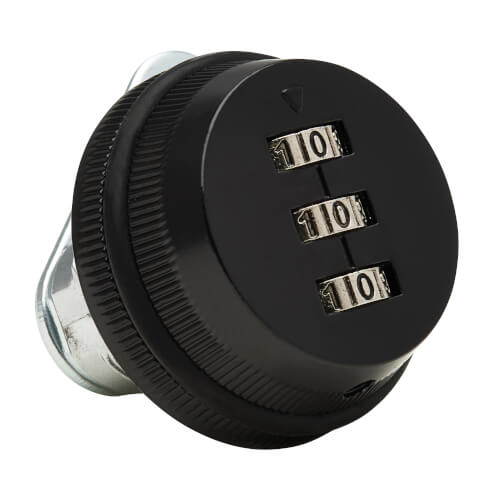
Security Accessories, such as door locks, camera mounts, and tamper-evident seals, are used to enhance the physical security of the server rack and protect equipment from theft or tampering.

Blanking Panels, also known as blanking plates, are physical barriers that are placed in open spaces within server racks to fill gaps between installed equipment. They are designed to improve airflow and increase cooling efficiency in data centers and server rooms.
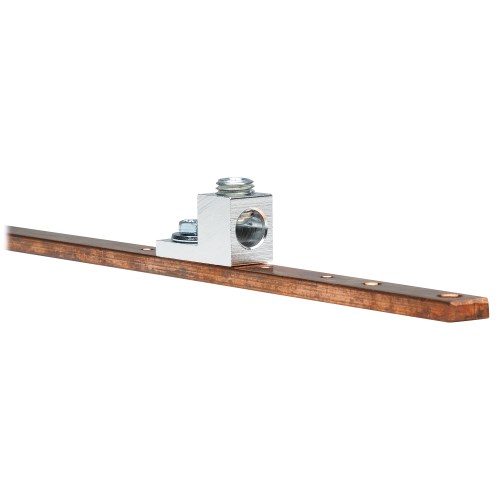
Grounding Bars are typically made of copper or other conductive materials and are mounted on the back or side of the server rack. They are designed to be connected to the grounding system of the building or facility using a grounding wire or strap.
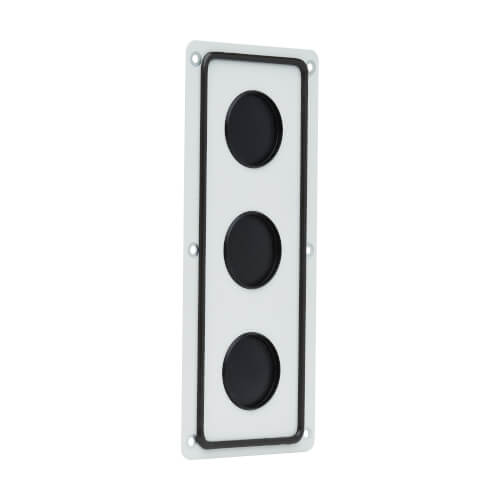
Gland Plates are typically made of metal or plastic, and are placed on the top, bottom, or sides of a server rack. They have pre-cut holes that are designed to accommodate cables of different sizes and are fitted with grommets to provide strain relief and prevent cable damage.
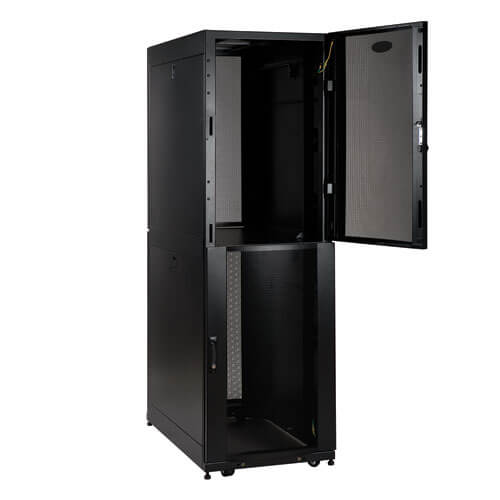
Colocation Kits divide a server rack into separate compartments so a single rack can be shared by multiple companies. Kits are often provided by data center operators as part of their service offerings.

Security Cages are typically made of heavy-duty steel mesh or perforated metal panels. They are designed to protect valuable and sensitive equipment stored in server racks from unauthorized access or theft.

Sensors are installed in a server rack to monitor environmental factors, such as temperature, humidity, and airflow, and physical status, such as door open/closed.
Open-frame racks are simple 2-post or 4-post racks without doors or side panels. They are typically used in situations where security is not a major concern and where easy access to the equipment is important.
Here are some common use cases for Open-frame racks:
Cabinet racks, also known as rack enclosures, are fully enclosed racks with locking doors and side panels. They provide better security and protection for equipment compared to open-frame racks. Here are some common use cases for cabinet racks:
Wall-mounted server racks are commonly used in situations where floor space is limited or where it is not practical to use a full-sized server rack.
Here are some common use cases for wall-mounted server racks:
Portable racks, also known as mobile racks, are designed to be easily moved and are ideal for situations where deployment is temporary. Here are some common use cases for portable racks:
Specialty server racks are designed for specific equipment types or specialized environments. Typical examples include process industries, factories and warehouses, transportation terminals and areas prone to earthquakes.
Here are some common use cases for specialty server racks:
Rack & Accessory Specifications
 |
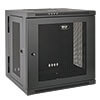 |
 |
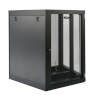 |
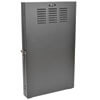 |
||
| Patch-depth | Switch-depth and Switch-depth-plus | UPS-depth | Server-depth | Vertical-mount | ||
| Features | For devices up to 13 in. deep | For devices up to 20.5 in. deep | For devices up to 24.5 in. deep | For devices up to 32.5 in. deep | For devices up to 36 in. deep | |
| Rack height | 12U - 18U | 2U - 26U | 12U - 26U | 12U - 18U | 2U - 16U | |
| Maximum load capacity | Up to 250 lb. [113 kg] | Up to 250 lb. [113 kg] | Up to 250 lb. [113 kg] | Up to 500 lb. [227 kg] | Up to 400 lb. [181 kg] | |
| Hinged back | Select Models | Select Models | Yes | Select Models | No | |
| Doors | Lockable; Reversible | Lockable; Reversible | Lockable; Reversible | Lockable; Reversible | Lockable; Reversible (Select) | |
| Mounting rails | Square and round/threaded hole | Square and round/threaded hole | Square and round/threaded hole | Square and 12-24 threaded hole | Supports M6 and 12-24 mounting | |
| Airflow management | Ventilated side panels and door | Ventilated side panels and door | Ventilated side panels and door | Ventilated side panels and door | Vented side panels (select) and door | |
| Built-in cable management | Top and bottom routing ports | Top and bottom routing ports | Top and bottom routing ports | Top and bottom routing ports | Top and bottom routing ports; Side (select) | |
| Special features | Clear acrylic window; IP20 | Clear acrylic window; IP20; IP54/NEMA 12 (Select) | Clear acrylic window; IP20 | Side-mount (Select); IP20 | Low profile; IP20 |
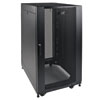 |
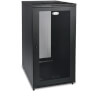 |
 |
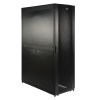 |
 |
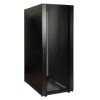 |
||
| Shallow-depth | Mid-depth | Standard-depth | Deep | Wide | Deep and wide | ||
| Features | For devices < 28 in. deep | For devices 28 - 33.5 in. deep | For devices 34 - 39.5 in. deep | For devices > 40 in. deep | 750 mm in width | For devices > 40 in. deep; 750 mm in width | For devices 41 - 54 in. deep; 800 mm in width |
| Rack height | 25U - 45U | 12U - 45U | 25U - 48U | 14U - 48U | 42U - 48U | 42U - 48U | 42U - 48U |
| Maximum load capacity | Up to 3000 lb [1361 kg] | Up to 3000 lb [1361 kg] | Up to 3000 lb [1361 kg] | Up to 3000 lb [1361 kg] | Up to 3000 lb [1361 kg] | Up to 3000 lb [1361 kg] | Up to 5000 lb [2268 kg] |
| Doors | Lockable; Reversible | Lockable; Reversible | Lockable; Reversible | Lockable; Reversible | Lockable; Reversible | Lockable; Reversible | Lockable; Reversible |
| Mounting rails | Square or 10-32 hole | Square | Square or 10-32 hole | Square | Square | Square | Square |
| Airflow management | Ventilated side panels and door | Ventilated side panels and door | Ventilated side panels and door | Ventilated side panels and door | Ventilated side panels and door | Ventilated side panels and door | Ventilated door |
| Built-in cable management | Yes | Yes | Yes | Yes | Yes | Yes | Yes |
| Special features | IP20 | IP20; IP54/NEMA 12 (Select) | Clear acrylic window; IP20; IP54/NEMA 12 (Select) | IP20 | IP20 | IP20 | Reinforced to contain heavy equipment, such as AI servers |
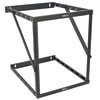 |
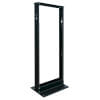 |
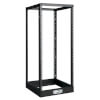 |
|
| Features | 2-Post wall-mount | 2-Post floor-standing | 4-Post floor-standing |
| Rack height | 12U - 22U | 12U - 45U | 12U - 58U |
| Maximum load capacity | Up to 200 lb [91 kg] | Up to 800 lb [363 kg] | Up to 3000 lb [1361 kg] |
| Mounting rails | Threaded 12-24 hole | Square or threaded 12-24 hole | Square or threaded 12-24 hole |
| Special features | Expandable 8U/12U/22U (select models) | - | Heavy-duty casters (select models) |
| Quiet racks | Seismic-certified racks | NEMA 12 (IP54) For harsh environments | |
| Special features | Specifically designed to minimize external acoustic levels caused by network equipment. Special foam sound-dampening baffles built into doors and side panels reduce acoustic levels by as much as 28 decibels. Ideal for small offices, recording studios, retail applications, classrooms and other areas where you need equipment to be secure, organized and quiet. | Designed and tested to meet Telcordia GR-63-CORE Network Equipment & Building Systems (NEBS) requirements for Zone 4 Seismic Earthquake Environments. Ideal for secure, high-density server and networking applications in IT environments that are earthquake-prone or subject to regular vibrations, such as an airport or factory. | Built with an IP54 (NEMA 12) protection rating and certified to protect equipment against dirt, dust, lint, oil, drips and splashes. Ideal for harsh, dirty work environments with limited floor space, such as factories, construction areas, utility plants, power stations, transportation terminals, distribution hubs and warehouses. |
Installs inside your rack enclosure to organize cabling and/or provide additional 0U mounting of PDUs and other devices and accessories with toolless mounting keyhole slots.
Prevents messy cable clutter by supporting and organizing cabling, while routing it from either side of the rack to interior connections.
Cuts down on cable clutter and stressed connections by safely supporting and segregating the equipment cabling from either side of the rack to interior connections.
Eliminates cable stress by organizing cabling across the top of your rack, neatly bundling it across an aisle or within a row of bayed racks.
Organizes and safely routes cabling across the top of a rack enclosure, creating a dedicated path that helps eliminate cable stress.
Hardware lets you mount cable ladders above your rack enclosures and extend them horizontally or vertically to maximize space.
Securely conceals your network or other cabling, protects it from damage, and keeps it neat and organized outside of walls.
Must-have accessory for keeping bundles of cables manageable.
Recommended for setting up network or digital signage installations that require cabling to run along walls and ceilings, above drop ceilings or through inner duct systems for long distances.
Blanking panels, brush strips, etc. improve cooling efficiency by blocking unwanted airflow and preventing recirculation.
Directs warm air away from your rack equipment or cool air directly toward it to improve your cabinet's airflow and keep your equipment at peak levels.
Hardware and other accessories for mounting rack equipment or managing cabling in your data center.
Brackets and rack extensions for your KVM, patch panels and DIN rails.
Shelves and locking draws for convenient storage of laptops, towers, tools, cables, etc.
Provides extra support for your KVM, UPS system or other rack equipment.
Extra locks and panels to protect your rack equipment from damage, tampering or theft.
A rack unit (RU), also known as a "U", is a standard unit of measurement used in server racks and other IT equipment enclosures. One rack unit is equal to 1.75 inches (44.45 mm) in height.

The height of a piece of IT equipment is typically measured in rack units to determine how much space it will occupy in a server rack. For example, a UPS battery backup that is 3 rack units high would occupy 5.25 inches (133.35 mm) of vertical space in a server rack.
The use of rack units allows IT professionals to easily determine the amount of space needed to install and mount equipment in a server rack. It also helps ensure that equipment from different manufacturers can be easily interchanged or replaced without compatibility issues, as long as they adhere to the same standard.
The size of the server rack you need will depend on the specific requirements of your setup, including the number of servers and network devices you need to house, available space, and future growth plans. Here are some factors to consider when determining the size of server rack you need:
Once you have determined the number of devices and the space required, you can select a server rack with the appropriate height and number of rack units (RU). For example, if you need to house 10 servers, you may want to consider a 24RU server rack, which is typically 48 inches (121.92 cm) in height. Remember to take into account any additional accessories or add-ons you plan to use when selecting the size of the server rack you need.
Internal Width: The standard internal width of a server rack is 19 inches (48.26 cm). This size is used for compatibility across different types of equipment. The width is measured between the inner edges of the two vertical rails that run the full height of the rack.
The 19-inch width is a standard that has been in use for many decades and is commonly referred to as the "EIA-310" standard. It was developed by the Electronics Industry Alliance (EIA) and has become widely adopted in the IT industry for mounting equipment such as servers, switches, and other networking hardware.
There are also wider server racks available, such as 23-inch and 24-inch models, that can accommodate larger equipment or provide more space for cable management. These wider racks are less common than the EIA-310 compliant 19-inch models and may be used in specialized applications or industries.
External Width: The external width of a server rack can vary depending on the specific model and manufacturer, but most standard server racks have an external width of approximately 23.6 inches (600 mm) to 24 inches (610 mm).
750 mm (29.5 inches) racks are sometimes referred to as "wide racks". They are typically found in data centers where the additional space is used for cable management, power distribution, and other components, which can help improve airflow and reduce clutter.
The depth of a server rack can vary depending on the manufacturer and the specific model, but the most common depth for a server rack is between 36 and 42 inches (91.44 to 106.68 cm). The depth is measured from the front to the back of the rack and typically includes the space occupied by the equipment and any cabling.
It's important to choose a server rack with an appropriate depth to accommodate your equipment and any cabling required. You should measure the depth of your equipment and ensure that there is enough space in the server rack to accommodate it. A good rule of thumb is to allow at least 3-inches for cabling.
In addition to the standard depth, there are also shallower and deeper server racks available. Shallower racks, typically around 24 inches (60.96 cm) deep, are useful for networking gear in locations where space is limited, such as small offices or wiring closets. Deeper racks, typically around 48 inches (121.92 cm) deep, are useful for environments with larger equipment or for high-density server environments.
The weight of an empty server rack can vary depending on the specific model, the material it's made of, and the number and type of accessories installed. An extra-tall, heavy-duty rack like the Eaton SR55UB weighs in at 375 lbs. but in general, a standard 42U server rack made of steel can weigh between 150 and 250 pounds (68 to 113 kg) when empty. However, the weight can increase significantly when the rack is fully loaded with equipment.
It's important to consider the weight of the fully populated rack when determining the placement and installation. Check the maximum static weight capacity and ensure that your rack can support your setup. If you plan on moving or transporting the server rack (for example, if you plan on populating the rack at a center location, then shipping it to a branch office), you should also consider the maximum dynamic (rolling) weight capacity.
The amount of space that a server rack needs will depend on the specific model, the number of rack units (RU) it has, and the requirements of the equipment being housed. However, a typical 42U server rack, which is the standard height for most data center and enterprise implementations, requires about 24 to 32 square feet (2.2 to 3 square meters) of floor space.
It's important to ensure that the server rack has enough space to accommodate the equipment and any additional accessories or add-ons, as well as providing sufficient clearance for cable management, airflow, and maintenance. You should measure the available space and ensure that there is enough room to install the server rack with adequate clearance on all sides.
In addition to the floor space, it's also important to consider the vertical space when planning for a server rack. A 42U server rack, for example, is about 78 inches (198 cm) in height and requires enough clearance to be installed upright.
The height of a server rack is typically measured in rack units (RU), where one rack unit is equivalent to 1.75 inches (4.45 cm) in height. The most common height for a server rack is 42U, which is about 78 inches (198 cm) tall. However, server racks are also available in other heights, ranging from 2U to 58U or more.
When selecting a server rack, it's important to choose a height that is appropriate for your equipment and the available space. You should consider the number of devices you need to house and plan for additional capacity to accommodate future growth. It's also important to ensure that the rack can be installed in the available space and that there is enough clearance for proper airflow and maintenance.
In addition to the standard height of the server rack, it's also important to consider any additional height that may be added by accessories or add-ons, such as cooling fans or cable management systems. These accessories can add additional height to the rack and may need to be taken into account when planning for the overall height of the server rack.
Soundproofing a server rack is a good idea when the rack will be located in work areas, such as offices, recording studios, or residential areas.
The best solution is a soundproof enclosure. These enclosures are designed to reduce noise levels by isolating the IT equipment from the surrounding environment.
To reduce noise levels from an existing rack, install acoustic foam panels inside the server rack. Acoustic foam panels are designed to reduce sound reflections and can be cut to size to fit inside the server rack. Another option is to hang acoustic curtains around the server rack. These curtains are made of heavy-duty material and can be installed using grommets or other mounting hardware. Finally, sound dampening pads can be placed under the server rack to absorb vibration and reduce noise.
If noise is coming from cooling fans, use fan speed controllers and temperature sensors to regulate fan speed and ensure proper cooling.
The amount of heat that a server rack produces depends on the type of equipment in the rack, the number of devices installed, and the workload of the equipment. However, as a rule, a fully loaded server rack can produce anywhere between 4 and 20 kilowatts of heat, or more.
You can approximate the heat produced by a server rack (and therefore its cooling needs) by calculating the total heat output of all the devices in the rack. Almost all the power consumed by IT devices is converted into heat, so a server that consumes 300W will have a thermal output of approximately 300W (multiply by 3.41 to convert watts to BTU/h).
If your rack includes a UPS, it's even easier. Use the power capacity of the UPS to estimate the cooling load. For example, if the UPS has an output capacity for 1,800 watts, assume the thermal output is 1,800 watts also.
The heat produced by a server rack can have a significant impact on the surrounding environment and can contribute to cooling costs and energy consumption. It's important to ensure that the rack is properly cooled, and airflow is optimized to prevent overheating and equipment failure.
Specific grounding (or earthing) requirements may vary depending on the electrical code in your country or state. A good place to start is the TIA Standard for Telecommunications Bonding and Grounding (TIA-607-D).
It is important to ensure that all grounding connections are tight and bonded to metal rather than paint. This helps to ensure a low-resistance path for electrical currents.
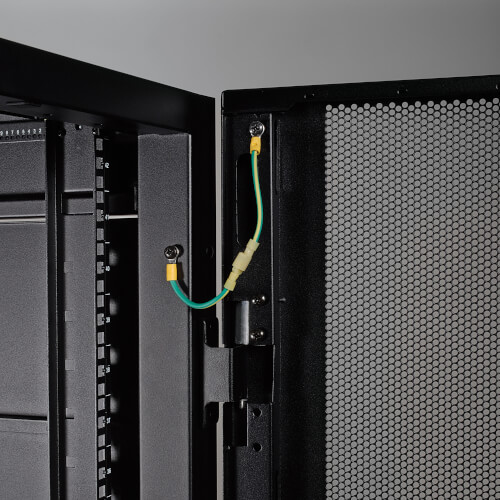
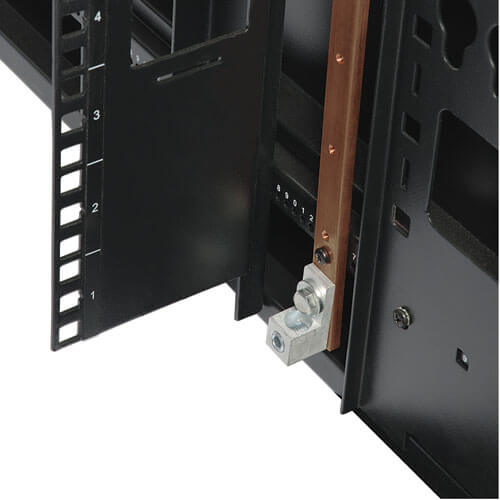
To ensure compliance with the specific grounding standards and electrical codes applicable to your location, it's recommended to consult with a qualified electrician or an expert familiar with local regulations.
Grounding Options
Eaton Grounding Accessories
The choice between 2-post and 4-post open-frame racks depends on the specific requirements of your application. For lighter equipment or situations where space and budget are limiting factors, a 2-post rack might be a better choice. If you have heavier equipment and require more stability and flexibility in depth, consider a 4-post rack.
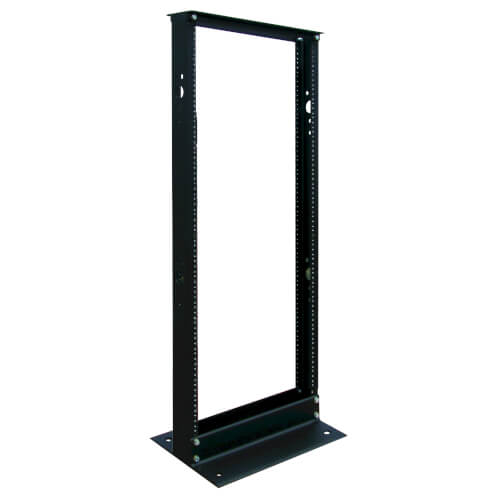
2-Post Open Frame Racks
Also known as relay racks, 2-post racks have two vertical posts to which equipment is mounted. The term "relay" comes from the telecommunications industry, referring to relay switches that were often mounted on these types of racks. In network closets, they are typically used for lightweight equipment, such as patch panels and network switches. Heavy devices, such as UPS systems and battery packs, are mounted at the bottom of the rack to provide added stability.
Advantages
Disadvantages
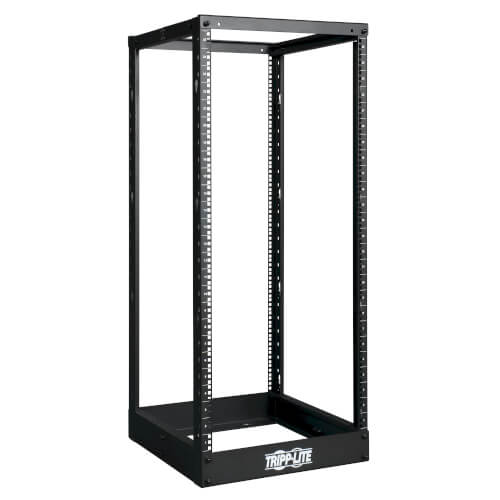
4-Post Open Frame Racks
Occasionally (and erroneously) referred to as 4-post relay racks, 4-post racks have four vertical mounting posts and are generally more robust than 2-post racks. They are designed to hold more and heavier equipment, such as servers, UPS systems, and large network routers.
Advantages
Disadvantages
Moving a server rack can be a complex task due to the weight, fragility, and importance of the equipment contained within it. Here is a general process for moving a server rack. Please note, this is a simplified process and actual procedures can vary based on the size of your server rack, the equipment in it, and the distance you're moving it.
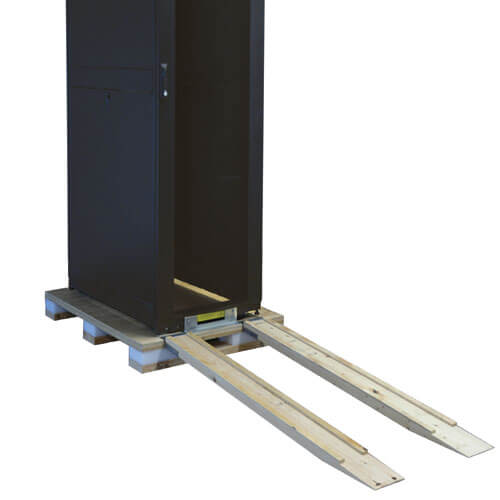
Please remember, this process can involve risks, both to the people moving the rack and the equipment within it. If you're unsure or uncomfortable doing it yourself, consider hiring professionals who have experience moving server racks.
Server Rack Glossary of Terms
All-Metal Frame
Server racks constructed from heavy-duty, all-metal steel frames with a durable black powder-coated finish that are virtually indestructible.
Cable Management
Shelves, mounting rails, stabilization, cooling, patch panels, hardware kits, casters, cable ducts and troughs enable custom installations to accommodate any space limitation or expansion requirement.
Cable Routing
Convenient ports with removable covers allow cable routing through top and bottom of rack units.
Clear Acrylic Window
Acrylic windows allow you to monitor equipment without unlocking rack doors.
Co-Location
Some data center sites host multiple users in a single rack cabinet. Co-location racks have two separate compartments to allow secure access to the correct users.
Expansion Rack
Expansion racks can be attached or “bayed” together easily to form rows, which is ideal for hot-aisle/cold-aisle cooling techniques.
Extra Width Rack
Extra wide racks provide extra width space for additional cables and improved airflow.
Front-to-Rear Airflow
Most racks feature front-to-rear airflow that supports efficient hot-aisle/cold-aisle configurations and exceed server manufacturer requirements to keep equipment operating reliably.
Heat Removal
Thermal duct rack enclosures directly connect to a facility's exhaust system to remove hot air not only from the rack but from the entire room.
Hinged Back
Select rack cabinets swing away from the wall on a sturdy hinge, allowing easy access to equipment and cabling during installation and maintenance.
Knockdown Rack
Racks ship fully assembled for easy installation. However, sometimes doorways or tight spaces cannot accommodate fully assembled racks, so knockdown models ship disassembled for easier transportation.
Locking Cabinet
Rack locking cabinets secure and organize standard 19 in. rack equipment. They provide security for servers, routers, hubs, UPS systems and other essential network equipment.
Network Equipment-Building System (NEBS)
NEBS (Network Equipment-Building System) describes the environment of a typical United States RBOC Central Office. NEBS is the most common set of safety, spatial and environmental design guidelines applied to telecommunications equipment in the United States. It is an industry requirement, but not a legal requirement.
Open-Frame Rack
Expandable open-frame racks store 8U, 12U or 22U of 19-inch rack equipment up to 18 inches deep in locations with limited floor space where a locked enclosure is not required. Allows easy access to equipment and cabling.
Patch-Depth
Racks specifically designed to accommodate patch panel depths up to 13 inches.
PCI and PCI DSS-Compliant
The Payment Card Industry (PCI) data security standard requires that all companies that process, store or transmit credit card information maintain a secure environment. PCI-compliant racks provide physical equipment and media security required for PCI DSS compliance.
Quiet Rack
Racks specifically designed to minimize external acoustic levels caused by network equipment. Special foam sound-dampening baffles built into doors and side panels reduce acoustic levels by as much as 28 decibels.
Rack Depth
Rack depth is dictated by the deepest device you want to install. Determine the maximum rack depth required to mount your equipment in a floor-standing or wall-mount rack enclosure cabinet.
Reversible Front Door
Rotate rack cabinets 180° before mounting to open reversible front door left or right.
Roll-Through Capability
Some rack cabinets come pre-assembled and can be rolled through standard 7-ft. (2.13m) commercial doorways. This allows network equipment to be racked, cabled and rolled into place in a server room for easy installation.
Seismic Protection
Seismic server racks have a rugged welded construction and are tested to Seismic Zone 4 standards, making them ideal for sites that are earthquake-prone or are subject to regular vibration, such as an airport or factory.
Shock Pallet Packaging
Shock pallet racks feature additional reinforcement and shock-absorbing material for safely re-shipping loaded racks to remote sites.
TAA-Compliant
GSA scheduled purchases and other government contracts require products that comply with the Trade Agreement Act (TAA).
Vented Rack Panel
Vented rack panels allow generous airflow that keeps equipment cool.
Vertical-Mount Rack
Vertical-mount racks extend less than 12 inches from the wall while housing equipment up to 36 inches deep, including 1U servers, UPS systems, battery packs and switches.
Vertical Mounting Rail
Vertical mounting rails adjust in 7/8-inch increments to accommodate equipment up to 16.5 in. deep, such as network switches and patch panels.
Wall-Mount Rack
Wall-mount racks offer secure organization for standard 19-in. rack equipment and can support depths up to 36 in. in locations with limited floor space.